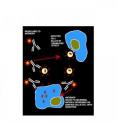Radioimmunotherapy: Promising treatment for HIV infection and viral cancers
Scientists at Albert Einstein College of Medicine of Yeshiva University have piggybacked antibodies onto radioactive payloads to deliver doses of radiation that selectively target and destroy microbial and HIV-infected cells. The experimental treatment — called radioimmunotherapy, or RIT — holds promise for treating various infectious diseases, including HIV and cancers caused by viruses. The research was presented today at the annual meeting of the American Association for the Advancement of Science (AAAS), the world's largest general scientific society and the publishers of the journal Science. The talk, part of the AAAS Topical Lecture Series, was delivered by Ekaterina Dadachova, Ph.D., a leading RIT researcher at Einstein. Dr. Dadachova is the Olnick Faculty Scholar in Cancer Research, as well as an associate professor of nuclear medicine and of microbiology & immunology at the College of Medicine.
RIT, which is currently used in cancer treatment, capitalizes on the fact that each type of antibody is programmed to seek out just one type of antigen in the body. Thus, by attaching radioactive material to a particular antibody, radiation can be targeted at specific cells that express the corresponding antigen, minimizing collateral damage to other tissues. This level of specificity is not possible with existing forms of radiation therapy.
RIT was originally developed as a therapy for cancer treatment and has been the most successful so far in treatment of non-Hodgkin lymphoma, a cancer that originates in cells of the immune system. Over the last few years, in collaboration with Dr. Arturo Casadevall, Chair and Forchheimer Professor of Microbiology & Immunology at Einstein, Dr. Dadachova has adapted the technique for fighting fungal, bacterial, and viral infections. Drs. Dadachova and Casadevall performed these studies in conjunction with scientists at Einstein and NYU, and at the European Commission Joint Research Centre; the latter of which supplied some of the important radionuclides for arming the antibodies.
Since viruses are quite different from cancer cells, devising radioimmunotherapy for HIV posed significant challenges. Viruses are tiny bits of DNA or RNA wrapped in a thin protein coat. Simple, tough, and resilient, viruses easily shrug off radiation directed at them and can readily repair any damage that might occur. Complicating matters, HIV can hide in immune cells keeping the virus beyond the reach of antibodies.
"Our approach is not to target the virus particles themselves, but rather lymphocytes that harbor the virus," says Dr. Dadachova. "Fortunately, lymphocytes are among the most radiosensitive cells in the body."
The RIT devised by Einstein researchers consists of an antibody for glycoprotein 41 (gp41) and a radioactive isotope called Bismuth-213, bound together with a special molecule known as a ligand. The gp41 antibody was selected because its corresponding gp41 antigen is reliably expressed on the surface of cells infected with HIV. In addition, unlike other HIV-related glycoproteins, gp41 antigen usually is not shed into the bloodstream, which would lead many of radioactive-labeled antibodies to miss their target. Bismuth-213 was chosen because of several characteristics, including a half-life, or decay rate, of 46 minutes. Such a short half-life rate allows just enough time for the treatment to be administered and for the radioactive antibodies to do their job. After four hours, Bismuth-213 radioactivity falls to negligible levels.
Drs. Dadachova and Casadevall and their colleagues have demonstrated that the treatment can effectively eliminate HIV-infected human cells in both laboratory and animal studies, the latter involving two different models of mice with HIV. The team is now conducting pre-clinical testing of the therapy's efficacy and safety in preparation for a Phase I clinical trial in HIV-infected patients.
RIT also has potential as a therapy for cancers that are preceded by viral infections, such as cervical cancer (certain forms of which are associated with human papilloma virus) and hepatocellular carcinoma (associated with hepatitis B virus). Such cancers account for almost a quarter of all cancers. "Many virus-associated cancer cells continue to express viral antigens," Dr. Dadachova explains. "As these antigens are not found anywhere else in the body, RIT of viral cancers promises exquisite specificity of treatment and very low toxicity to the patient."
Source: Albert Einstein College of Medicine
Other sources
- Promising treatment for HIV infection and viral cancersfrom Science BlogMon, 16 Feb 2009, 1:21:17 UTC
- Promising treatment for HIV infection and viral cancersfrom Science BlogSun, 15 Feb 2009, 1:56:26 UTC
- Radioimmunotherapy: Promising Treatment For HIV Infection And Viral Cancersfrom Science DailySat, 14 Feb 2009, 22:21:11 UTC
